
Bangkok is the vibrant and chaotic capital of Thailand, where centuries-old temples stand alongside glittering skyscrapers and buzzing street markets. Known as the "City of Angels", it offers a rich blend of culture, cuisine, and contrasts—royal palaces, colorful tuk-tuks, serene riverside temples, and world-famous street food all coexist in an electrifying atmosphere. Whether you're seeking luxury or authenticity, tradition or nightlife, Bangkok is a city that never stops surprising.
Bangkok, the bustling capital of Thailand, has a rich and fascinating history that stretches back centuries. Known in Thai as "Krung Thep Maha Nakhon," which translates to "City of Angels," Bangkok has evolved from a small riverside village into one of Southeast Asia’s most dynamic and influential cities.
The earliest mention of Bangkok dates back to the 15th century when it served as a small trading post during the Ayutthaya Kingdom. Situated on the western bank of the Chao Phraya River, the village was ideally located to support maritime trade between China, India, and the rest of the region. Merchants would stop in Bangkok to trade goods, rest, and resupply before continuing their journey.
As trade increased, so did Bangkok’s importance. During the late Ayutthaya period in the 17th century, the area began to grow in strategic significance. The Siamese monarchy recognized its value and constructed forts and walls along the river to protect against foreign invaders and pirate attacks. The settlement became a frontline defense point, especially against European colonial interests.
In 1767, the ancient capital of Ayutthaya was sacked by Burmese forces, plunging Siam into chaos. General Taksin emerged as a national hero by rallying forces and reclaiming lost territory. He established a new capital in Thonburi, directly across the river from modern-day Bangkok. Thonburi served as the capital for a brief period until Taksin was overthrown in 1782.
After General Taksin’s fall, General Chao Phraya Chakri ascended the throne as King Rama I, founding the Chakri Dynasty that still rules today. One of his first acts was to move the capital from Thonburi to the opposite bank of the Chao Phraya River. He named the new capital "Krung Thep," which is an abbreviated version of its full ceremonial name—the longest city name in the world.
King Rama I established the Grand Palace and Wat Phra Kaew (Temple of the Emerald Buddha), setting the stage for Bangkok as the spiritual, cultural, and administrative center of Thailand. The city was designed with canals and fortresses, earning it the nickname "Venice of the East" from early European visitors.
During the reigns of King Rama IV (Mongkut) and Rama V (Chulalongkorn), Bangkok underwent significant modernization. The monarchy adopted Western technologies and administrative reforms to avoid colonization, unlike many neighboring countries. Roads were built, printing presses introduced, and modern education promoted. In 1863, the first paved road, Charoen Krung Road, was constructed, linking key areas of the city.
King Chulalongkorn played a key role in transforming Bangkok into a modern city with railways, electricity, and improved infrastructure. He also initiated diplomatic relations with Western nations, helping Thailand maintain its sovereignty during a time of aggressive colonial expansion in Asia.
Bangkok continued to expand rapidly in the 20th century. It became the focal point of national politics, education, and commerce. After the 1932 revolution, which transformed Thailand from an absolute to a constitutional monarchy, Bangkok saw rapid urbanization. Highways replaced canals, skyscrapers replaced traditional wooden houses, and Western cultural influences grew stronger.
Throughout the mid-20th century, the city also experienced political unrest, student protests, and coups d'état, shaping the democratic institutions that exist today. Despite political volatility, Bangkok remained a cultural and economic powerhouse.
From the 1980s to the late 1990s, Bangkok enjoyed unprecedented economic growth. Thailand became one of the "Asian Tigers," and the capital witnessed a construction boom. Modern office buildings, luxury hotels, and shopping centers transformed the city’s skyline. Infrastructure like the BTS Skytrain and MRT subway system were introduced to accommodate the growing population and traffic congestion.
During this period, Bangkok became a hub for international tourism, trade, and finance, attracting millions of visitors each year. The city’s blend of modern amenities and cultural heritage made it one of the world’s top travel destinations.
Today, Bangkok is a megacity with over 10 million residents. It continues to evolve while preserving its historical landmarks and traditions. The city hosts global events, art festivals, and international conferences, further cementing its role on the world stage.
From the ornate spires of the Grand Palace to the bustling night markets and modern rooftop bars, Bangkok offers a dynamic experience that reflects both its rich past and its aspirations for the future. Whether you're interested in history, cuisine, spirituality, or contemporary urban life, Bangkok delivers a story that is constantly unfolding.
Bangkok’s history is not just a tale of kings and conquests, but of resilience, adaptation, and innovation. It stands today not just as the capital of Thailand, but as a symbol of Southeast Asia's ability to embrace change while honoring tradition.